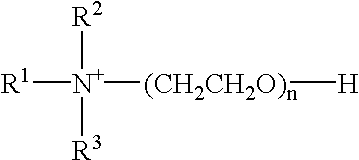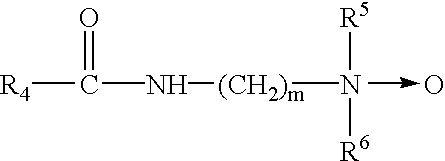[0018] It is also an object of this invention to provide a
hard surface cleaner which, despite having
antimicrobial efficacy, has improved greasy soil removal with no adverse effects on filming / streaking performance, surprisingly despite having a hydrophilic cationic surfactant.
[0034] One of the most surprising facets of this invention was the discovery that an alkoxylated
quaternary ammonium surfactant would result in enhanced soil removal performance and improved streaking / filming performance. This was very unexpected since it is considered an orthodoxy in surfactant
chemistry that quaternary ammonium compounds will cause a large amount of residue to occur on surfaces treated therewith.
[0048] The amounts of surfactants present are to be somewhat minimized, for purposes of cost-savings and to generally
restrict the dissolved actives which could contribute to leaving behind residues when the cleaner is applied to a surface. The ratio of the hydrophilic cationic surfactant to the nonionic or amphoteric surfactant is about 20:1 to 1:1, more preferably about 10:1 to 1:1.
[0054] Alkanolamines are the preferred
solvent /
alkalinity source herein. Preferred are monoethanolamine, monopropanolamine and monobutanolamine, with monoethanolamine (MEA) being most preferred. MEA apparently helps to mitigate the reduction in soil removal that typically occurs when quaternary ammonium (especially
chloride) compounds are used. Monoethanolamines (and other alkanolamines) should be present in an amount between 0.01 to 5%, most preferably between about 0.1 to 5% by weight.
[0058] It is preferred to use an alkylene glycol
ether solvent in this invention. The alkylene glycol
ether solvents can include
ethylene glycol monobutyl ether,
ethylene glycol monopropyl ether,
propylene glycol n-
propyl ether,
propylene glycol monobutyl ether,
diethylene glycol n-butyl ether,
dipropylene glycol methyl ether, and mixtures thereof. Preferred
glycol ethers are
propylene glycol n-butyl ether (sold as Dowanol PNB, sold by Dow Chemical Co.),
ethylene glycol monobutyl ether, also known as butoxyethanol, sold as butyl Cellosolve by Union
Carbide, and also sold by Dow Chemical Co., 2-(2-butoxyethoxy)
ethanol, sold as
butyl Carbitol, also by Union
Carbide, and propylene glycol n-
propyl ether, available from a variety of sources. Another alkylene glycol ether is propylene glycol, t-butyl ether, which is commercially sold as Arcosolve PTB, by Arco Chemical Co. The n-butyl ether of propylene glycol is most preferred. Other suppliers of preferred solvents include Union
Carbide. If mixtures of solvents are used, the amounts and ratios of such solvents used are important to determine the optimum cleaning and streak / film performances of the inventive cleaner. It is preferred to limit the total amount of
solvent to no more than 50%, more preferably no more than 25%, and most preferably, no more than 15%, of the cleaner. A preferred range is about 1-15%, and a most preferred range is actually 0-5%, since these cleaners can actually be solventless. These amounts of solvents are generally referred to as dispersion-effective or solubilizing effective amounts, since the other components, such as surfactants, are materials which are assisted into solution by the solvents. The solvents are also important as cleaning materials on their own, helping to loosen and solubilize greasy soils for easy removal from the surface cleaned.
[0061] Small amounts of adjuncts can be added for improving cleaning performance or aesthetic qualities of the cleaner. For example, buffers could be added to maintain constant pH (which for the invention is between about 7-14, more preferably between about 8-13). These buffers include non-heavy
metal salts of weak acids, such as NaOH, KOH, Na.sub.2CO.sub.3, K.sub.2CO.sub.3, as alkaline buffers, and phosphoric, hydrochloric, sulfuric, sulfonic and citric acids as acidic buffers, and others. (These materials were also considered above, in 3.) Because alkanolamines are utilized, the pH will generally be relatively alkaline. Other builders, such as phosphates, silicates, and again, carbonates, may be desirable, but their amounts are preferably minimized since these materials may, in fact, worsen streaking / filming attributes since they may increase residue. Further solubilizing materials, such as hydrotropes, e.g.s.,
cumene,
toluene and
xylene sulfonates, may also be desirable. Adjuncts for cleaning include additional surfactants, such as those described in Kirk-Othmer,
Encyclopedia of
Chemical Technology, 3rd Ed., Volume 22, pp. 332-432 (Marcel-Dekker, 1983), and McCutcheon's Soaps and Detergents (N. Amer. 1984), which are incorporated herein by reference. Aesthetic adjuncts include fragrances, such as those available from Givaudan, IFF, Quest, Sozio, Firmenich, Dragoco and others, and dyes and pigments which can be solubilized or suspended in the formulation, such as diaminoanthraquinones. Water-insoluble solvents may sometimes be desirable as added
grease or oily soil
cutting agents. These types of solvents include
tertiary alcohols, hydrocarbons (alkanes), pine-oil, d-
limonene and other terpenes and
terpene derivatives, and benzyl alcohols. Thickeners, such as organic polymers, like polyacrylate,
starch,
xanthan gum, alginates,
guar gum,
cellulose, and the like, may be desired additives. Antifoaming agents, or foam controlling agents, may be also desirable, such as
silicone defoamers. The amounts of these cleaning and aesthetic adjuncts should be in the range of 0-10%, more preferably 0-2%. It is again emphasized that any additives be added in amounts which will not increase streaking / filming of the cleaner.
 Login to View More
Login to View More 


